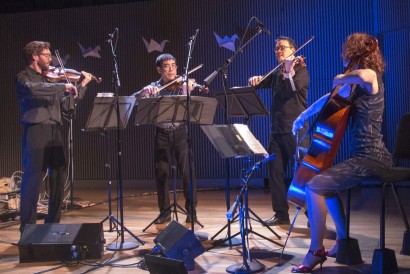Review of Del Sol String Quartet Concert 4-12-15
By Roger Emanuels, Performing Arts Monterey Bay, 4-13-15
PRESENTED BY the Santa Cruz Chamber Players, the Del Sol String Quartet offered a program tailored for Santa Cruz audiences accustomed to hearing cutting-edge works. All the composers represented on the program either have lived in Santa Cruz or have performed here with the Cabrillo Festival of Contemporary Music. And a world premiere by local resident Josef Sekon added a bit of expectation to the concert at Peace United Church in Santa Cruz on Sunday afternoon.
Founded in 1992, the Quartet is based in San Francisco and performs internationally. Much of their repertoire was written for them, and they have made several recordings of music composed within the past few decades. They performed a concert at the Cabrillo Festival in 2012 in a program that included some works heard on this outing.
The Del Sol is unique in that the violinists and the violist prefer to stand when they perform, breaking a 250-year-old tradition of a seated string quartet. This surely gives them more freedom to interact. Another tradition broken is that the two violinists trade off on the first and second violin parts. Traditionally a first violinist always plays the demanding upper register parts in the symphony and string quartet, while the second violinist is branded for life in the lower register with none of the melodic glory. But in contemporary music the parts are not bound to their traditional roles.
Opening the program was Fast Blue Village 2 (2007) by Elena Kats-Chernin, born in 1957 in Uzbekistan. The Del Sol had played this at their Cabrillo Festival appearance in 2012. It’s an energetic concert opener, good for getting the audience prepared for a concert of contemporary chamber music. Cabrillo Festival-goers are familiar with the music of Kats-Chernin, who has been a festival composer-in-residence three times since 2010. A very attractive rhythmic groove propels this music forward.
Lou Harrison’s String Quartet Set was the most classical work on the program, and the only music from the past century. It was composed while Lou was living in the hills of Aptos in 1978-79. The Kronos Quartet was first to record the work in 1981, and the Del Sol recorded it in 2013, after having performed it at the 2012 Cabrillo Festival. For those of us who have listened to Lou’s music at the Cabrillo and at New Music Works over many decades, it was a joy to see these younger musicians embrace Harrison’s spirit and sound-world.
Lou’s work is a delight to hear, as it introduces the medieval scales and rhythms that he was comfortable with. As in much of his music, there is an abundance of melody and rhythm with little regard to harmony. He draws from a wide variety of sources including a 12th century song, a medieval peasant dance, a French Baroque Rondeaux, and a Turkish rhythmic mode. The peasant dance, or Estampie, was a favorite of Lou’s that he used in many works, with a sustained drone, while the cellist becomes a percussionist with tapping the body of the cello and using a mallet on the strings.
The audience was eager to hear the world premiere of Josef Sekon’s Adendo, a one-movement work that explores just about every string technique available, creating colorful and vibrant sounds. There is a lot of plucking and sliding on the strings (what musicians call pizzicato and glissando). At times the tone clusters shimmer with harmonics and tremolo, sounding like a musical representation of clusters of butterflies. Sekon, on the music faculty at Cabrillo College, has created a high-energy piece that makes good use of the string quartet and all its resources. One can hope that the work will receive more exposure.
Lembit Beecher grew up in Santa Cruz in the 1980s and ‘90s and is an active performer and composer on the East Coast. His These Memories May Be True is a musical response to the stories of his grandmother who escaped from Estonia during World War II. An earlier work, a one-act opera based on the same stories, was premiered just last year at the Metropolitan Museum of Art.
Beecher’s approach is calm. Textures tend to be light, giving the impression that the composer is reluctant to use too many notes. The four movements have titles representing the grandmother’s stories. The first movement has a quiet and wistful mood, the second movement rhythmically engaged throughout. At times the musicians seem to be playing completely different gestures. The following movement is very sparse, with effective use of silence, proving that some musical statements can be accomplished with fewer means. The work’s finale creates beautiful moments of warm, sustained sound.
Huang Ruo was born in China in 1976 and now lives in the United States. His Shattered Steps had a world premiere at the 2012 Cabrillo Music Festival. He composed Calligraffiti for string quartet in 2009, the title being a fusion of the words “calligraphy” and “graffiti,” two images that reflect the composer’s experiences in China and in New York. Ruo draws on Chinese elements such as short slides between notes. Long, sustained tones in clusters give way to more fragmented statements. Even microtones are used, best described as notes between the tones of western scales. The work was by far the most challenging music on the program for the audience.
To cleanse the ear with an encore, the Quartet offered a movement from Quartet No. 14 by the late Australian composer Peter Sculthorpe, leaving the audience with warm and lyrical string tones.
The Del Sol excels with convincing performances. They are comfortable with each other and with the thorniest of scores. Their intonation is superb, allowing their sound to resonate. Most remarkable is how the players are very aware of balance, so that the listener can follow the action more easily. With new music, this is what makes it work in performance.

